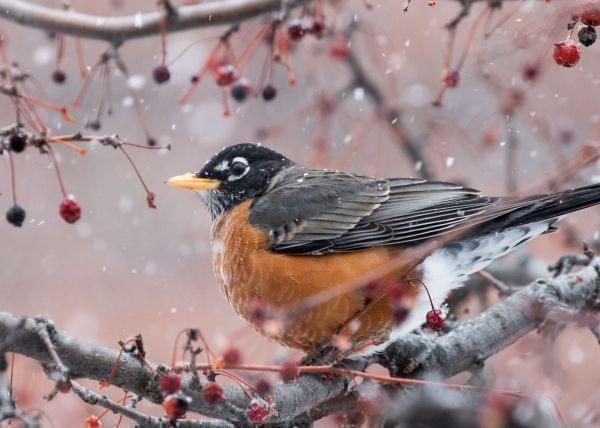American robins as harbingers of spring?

An American robin feasts on crabapples in a snowstorm. Rob Kanter
American robins have long been known as harbingers of spring, at least among Midwesterners. But to be a harbinger of spring, you have to go south for the winter, right?
There was a time when nearly all robins did. Records from the earliest Audubon Christmas Bird Counts in Illinois, for example, which go back to 1940, show very few wintering robins in the state until 1951. After that, however, robins observed on the Christmas counts increase gradually through the 1980s, and then really surge over the most recent two decades. Robins can now be found in all but the northernmost parts of Illinois through most winters.
Why the change?
I checked in recently to discuss the reasons with Mike Ward, an avian ecologist who holds appointments with the UI Department of Natural Resources and Environmental Sciences and the Illinois Natural History Survey, a division of the UI Prairie Research Institute.
Ward pointed out that, like other birds, robins have good reason to avoid migrating if they can. In part that’s because it is so risky: “Migrating birds are forced to look for food in unfamiliar territory and figure out how to avoid unknown predators. It’s a very dangerous time for them.” In addition, individuals that don’t migrate, especially males, are able to occupy breeding territories first in the spring, which gives them a reproductive advantage.
Ward noted that the northward expansion of the robin’s winter range might be facilitated by the long-term trend toward warmer winters and the availability of secure habitat in developed areas. But the most important factor by far is the availability of new sources of winter food.
“Contrary to popular perception,” he said,” birds don’t need to migrate to avoid cold. They just need to be able to eat enough to maintain their high metabolism.”
Robins have been able to spend winters farther north in recent decades because an enormous new source of food has become available to them, the berries of exotic, invasive shrubs, especially varieties of buckthorn and bush honeysuckle. These prolific, fast growing, hard-to-kill shrubs degrade natural areas by displacing native plants, thereby, disrupting entire ecosystems. But they are a boon to wintering robins because their hyper-abundant berries persist on the branch right through the coldest part of the year.
Unfortunately, robins thus are also a boon to these invasive plants, since for each berry they ingest they deposit a seed somewhere.
The northward expansion of the wintering range of robins has occurred in concert with a steady increase in their overall abundance in Illinois, as evidenced by the Breeding Bird Survey, which is an annual census conducted at the height of the breeding season. In the early years of the survey, which was begun in 1966, robins were observed at an average rate of fewer than 40 birds per survey route. That rate has grown steadily over time, and since the year 2000, an average of more than 100 robins per route have been observed, a 2.5X increase.
This population growth is also attributable to changes we’ve made in the landscape. “Robins love suburbanization,” said Ward. “Manicured, irrigated lawns make extremely poor habitat for most forms of wildlife, but they provide a perfect place for robins to hunt their favorite nesting-season food, which is earthworms.”
At least in this regard, robins still do behave according to script.
Bird Book Alert
If you’re interested in how bird populations in Illinois have changed over time, check out “Illinois Birds: A Century of Change.” This book summarizes the results of three systematic surveys of birds in the state dating back to 1906. It is available through the Illinois Natural History Survey in Champaign or online at https://shop.inrs.illinois.edu/INHS-gift.html.

